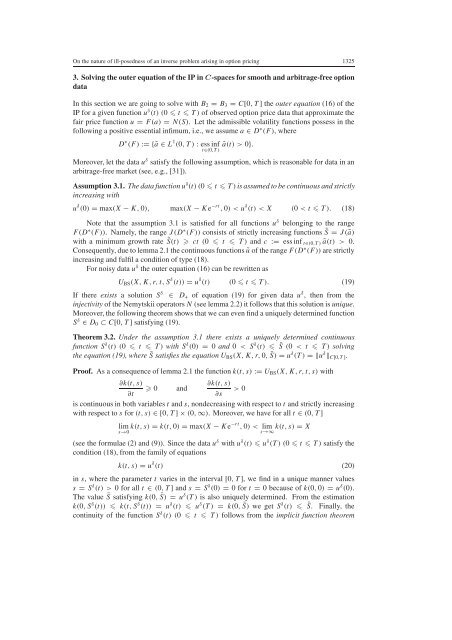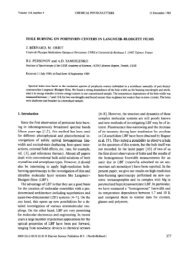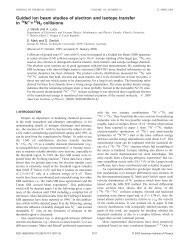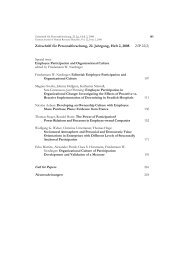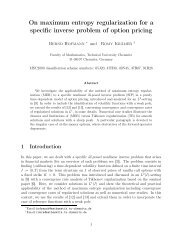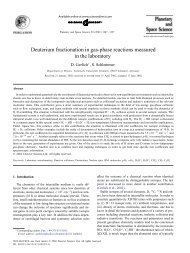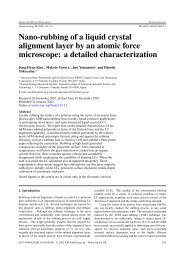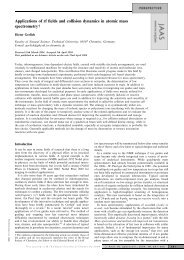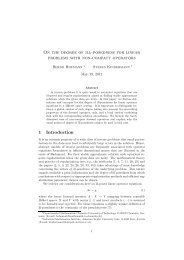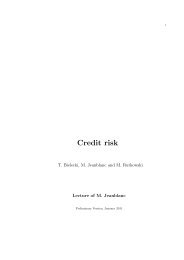On the nature of ill-posedness of an inverse problem arising in option
On the nature of ill-posedness of an inverse problem arising in option
On the nature of ill-posedness of an inverse problem arising in option
You also want an ePaper? Increase the reach of your titles
YUMPU automatically turns print PDFs into web optimized ePapers that Google loves.
<strong>On</strong> <strong>the</strong> <strong>nature</strong> <strong>of</strong> <strong>ill</strong>-<strong>posedness</strong> <strong>of</strong> <strong>an</strong> <strong><strong>in</strong>verse</strong> <strong>problem</strong> <strong>aris<strong>in</strong>g</strong> <strong>in</strong> <strong>option</strong> pric<strong>in</strong>g 1325<br />
3. Solv<strong>in</strong>g <strong>the</strong> outer equation <strong>of</strong> <strong>the</strong> IP <strong>in</strong> C-spaces for smooth <strong>an</strong>d arbitrage-free <strong>option</strong><br />
data<br />
In this section we are go<strong>in</strong>g to solve with B2 = B3 = C[0, T ]<strong>the</strong>outer equation (16) <strong>of</strong> <strong>the</strong><br />
IP for a given function uδ (t) (0 � t � T ) <strong>of</strong> observed <strong>option</strong> price data that approximate <strong>the</strong><br />
fair price function u = F(a) = N(S). Let <strong>the</strong> admissible volatility functions possess <strong>in</strong> <strong>the</strong><br />
follow<strong>in</strong>g a positive essential <strong>in</strong>fimum, i.e., we assume a ∈ D∗ (F),where<br />
D ∗ (F) := {ã ∈ L 1 (0, T ) :ess<strong>in</strong>fã(t)<br />
>0}.<br />
t∈(0,T )<br />
Moreover, let <strong>the</strong> data uδ satisfy <strong>the</strong> follow<strong>in</strong>g assumption, which is reasonable for data <strong>in</strong> <strong>an</strong><br />
arbitrage-free market (see, e.g., [31]).<br />
Assumption 3.1. The data function uδ (t)(0 � t � T ) is assumed to be cont<strong>in</strong>uous <strong>an</strong>d strictly<br />
<strong>in</strong>creas<strong>in</strong>g with<br />
u δ (0) = max(X − K, 0), max(X − K e −rt , 0) 0<br />
∂t<br />
∂s<br />
is cont<strong>in</strong>uous <strong>in</strong> both variables t <strong>an</strong>d s, nondecreas<strong>in</strong>g with respect to t <strong>an</strong>d strictly <strong>in</strong>creas<strong>in</strong>g<br />
with respect to s for (t, s) ∈ [0, T ] × (0, ∞). Moreover, we have for all t ∈ (0, T ]<br />
lim<br />
s→0 k(t, s) = k(t, 0) = max(X − K e−rt , 0) < lim k(t, s) = X<br />
s→∞<br />
(see <strong>the</strong> formulae (2) <strong>an</strong>d (9)). S<strong>in</strong>ce <strong>the</strong> data uδ with uδ (t) � uδ (T )(0 � t � T ) satisfy <strong>the</strong><br />
condition (18), from <strong>the</strong> family <strong>of</strong> equations<br />
k(t, s) = u δ (t) (20)<br />
<strong>in</strong> s, where<strong>the</strong>parameter t varies <strong>in</strong> <strong>the</strong> <strong>in</strong>terval [0, T ], we f<strong>in</strong>d <strong>in</strong> a unique m<strong>an</strong>ner values<br />
s = S δ (t) >0forallt ∈ (0, T ]<strong>an</strong>ds = S δ (0) = 0fort = 0because <strong>of</strong> k(0, 0) = u δ (0).<br />
The value ¯S satisfy<strong>in</strong>g k(0, ¯S) = u δ (T ) is also uniquely determ<strong>in</strong>ed. From <strong>the</strong> estimation<br />
k(0, S δ (t)) � k(t, S δ (t)) = u δ (t) � u δ (T ) = k(0, ¯S) we get S δ (t) � ¯S. F<strong>in</strong>ally, <strong>the</strong><br />
cont<strong>in</strong>uity <strong>of</strong> <strong>the</strong> function S δ (t) (0 � t � T ) follows from <strong>the</strong> implicit function <strong>the</strong>orem


